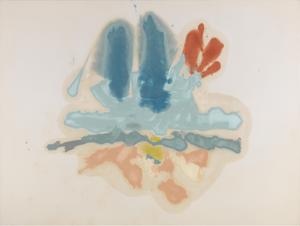
Pretty Raw: After and Around Helen Frankenthaler
The Rose Art Museum, Brandeis University, Waltham, MA
February 11 — June 7, 2015
Press Release / Info
(Waltham, MA.) – The Rose Art Museum at Brandeis University presents Pretty Raw: After and Around Helen Frankenthaler, a groundbreaking exhibition that reconsiders the history of modern art and its renewed meaning for contemporary artists, February 11 – June 7, 2015, in the Foster Gallery. An opening reception will be held from 5-8pm on Tuesday, February 10.
Pretty Raw takes the work of the artist Helen Frankenthaler (1928-2011) as the point of departure for an alternative version of modernist art over the past 50 years, a story usually written as a series of male masters. In this new history, decoration, humor, femininity and masculinity, the everyday, sensual pleasure, artifice and illusion, and authorial control take center stage, as artists from the 1950s through the present explore the personal, social, and political meanings of sheer, gorgeous materiality.
Katy Siegel, the Rose’s Curator-at-Large and organizer of the exhibition, asks, “How might it change our vision of the history of postwar American art to start with a female artist? How might it look seen through the lens of Helen Frankenthaler, whose paintings and image in the popular media take in so many of the questions modernism has suppressed? Beginning in 1950 and ending in 2015, Pretty Raw brings into focus a range of possible answers.”
Pretty Raw begins by looking at the 1950s, when Frankenthaler worked in a context that included Grace Hartigan, Jane Freilicher, Dwight Ripley, Marie Menken, and other artists and writers affiliated with the Tibor de Nagy Gallery. The work from these years infuses Abstract Expressionist materialism with playfulness, figuration, and a spirit that is at once everyday and dramatically artificial, in a picture of the 50s radically different from the commonplace image of big egos and broad strokes.
Working outwards from this moment, the exhibition traces several related phenomena: the artistic innovations of poured paint and stained raw canvas; the social implications of decoration; authorial control vs. materiality; the body and painting; and the image of the woman painter and related questions of gender and identity.
The later sections of the show frame the intersection of feminism and painting in easel paintings, large-scale works and performances by feminist artists in the 1970s and early 90s. Men as well as women embrace embodied role-playing and decorative motifs. While Frankenthaler herself, like many other women artists of her generation, preferred to distance herself from the feminist art movement, her example nonetheless was a powerful one for artists engaged in a feminist practice. As we approach the current moment, when the allure, social use, and bodily affect of color and form permeate contemporary art, Pretty Raw reveals the social implications and physical beauty already present in this history.
Selected artists: Helen Frankenthaler, Grace Hartigan, Jane Freilicher, Dwight Ripley, Larry Rivers, Nell Blaine, Al Leslie, Morris Louis, Jules Olitski, Sam Gilliam, Friedl Dzubas, Frank Bowling, Ralph Humphrey, Miriam Schapiro, Lynda Benglis, Harmony Hammond, Andy Warhol, Christopher Wool, Carroll Dunham, Polly Apfelbaum, Dona Nelson, Marilyn Minter, Kara Walker, Kathy Butterly, Jacqueline Humphries, Laura Owens, Mary Weatherford, Sterling Ruby, Ulrike Müller, Josh Faught.
